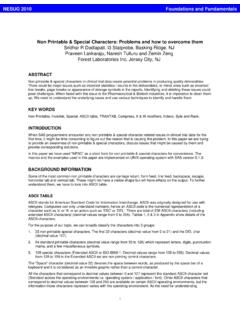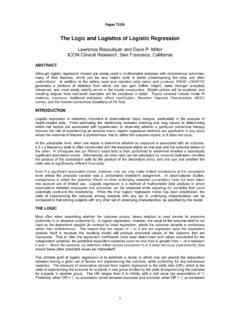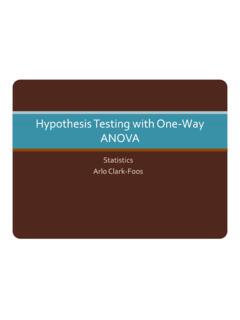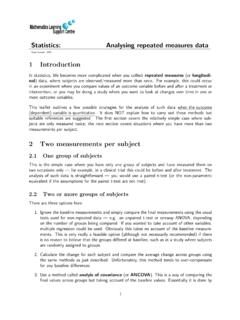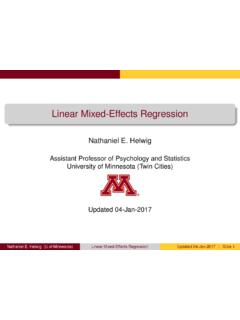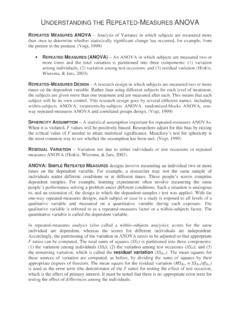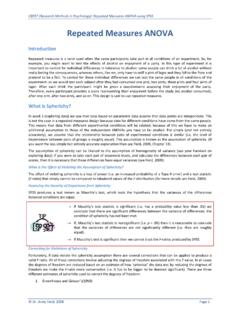Transcription of Mixed Model Repeated Measures (MMRM)
1 Paper AS06 Mixed Model Repeated Measures (MMRM) Mrudula Suryawanshi, Syneos Health, Pune, India ABSTRACT This specialized Mixed Models procedure analyzes results from Repeated Measures designs in which the outcome (response) is continuous and measured at fixed time points. The procedure uses the standard Mixed Model calculation engine to perform all calculations. However, the user-interface has been simplified to make specifying the Repeated Measures analysis much easier. These designs that can be analyzed by this procedure include Repeated - Measures designs Cross-over/ Parallel designs Designs with covariates.
2 This paper gives an abbreviated coverage of Mixed models in general focuses on response measurements assumed to be normally distributed. Non-normal data are also frequently collected in a Repeated Measures layout. INTRODUCTION Repeated Measures refer to multiple measurements taken from the same experimental unit, such as serial evaluation over time on the same patient. Special attention is given to these types of measurements because they cannot be considered independent. In particular, the analysis must make provisions for the correlation structure.
3 Most clinical studies require outpatients to return to the clinic for multiple visits during the trial with response measurements made at each. This is the most common example of Repeated Measures , sometimes called longitudinal data. These Repeated response measurements can be used to characterized a response profile overtime. One of the main questions the researcher asks is whether the mean response profile for one treatment group is the same as for another treatment group or placebo group. This situation might arise, when trying to determine if the onset of effect or rate of improvement due to a new treatment is faster than a competitor s treatment.
4 Comparison of response profiles can be tested with a single F-test from a Repeated Measures analysis. SYNOPSIS In general, you have g independent groups of patients each of whom are subjected to Repeated measurements of the same response variable, y, at t equally spaced time period. Letting ni represent no of patients in Group (i = 1, 2, .. , g), the layout for g=3 groups each shown in table below. In comparative trials, the groups often represent different parallel treatment groups or do levels of drug. Layout for a Repeated Measures Design with 3 Groups Group Patient ----------------------Time-------------- ------------- 1 2.
5 T 1 1 y111 y112 .. y11t 2 y121 y122 .. y12t .. n1 y1n11 y1n12 .. y1n1t 2 1 y211 y212 .. y21t 2 y221 y222 .. y22t.
6 N2 y2n21 y2n22 .. y2n2t 3 1 y311 y312 .. y31t 2 y321 y322 .. y32t .. n3 y3n31 y3n32 .. y3n3t There are number of analytical approaches for handling Repeated Measures . First, examine a univariate method that uses the same anova concepts.
7 A multivariate method, which treats Repeated measurements as a multivariate response vector, may also be used many circumstances. Also can use modelling techniques that use the Mixed and GENMODE procedures in SAS, which are often preferable if there are missing data. THE UNIVARIATE APPROACH Consider the group, patient, and time effects shown in table above as three factors in an anova . We can examine the variability within and among these factors, noting that the time effect represents correlated measurements.
8 Notice that the response might vary among groups, among patients within groups, and among the different measurement times. Therefore, include group effect, a patient (within group) effect, and time effect as sources of variation in the anova . In addition, the Repeated Measures analysis using a univariate approach includes the group-by-time interaction. As with other anova methods, assumption of normality of the response measurements and variance homogeneity among groups are considered to be satisfied.
9 In addition, the univariate anova requires that each pair of Repeated Measures has the same correlations, this feature is known as compound symmetry . A significant interaction means that changes in response over time differ among groups, significant difference in response profiles. When profiles are similar among groups ( no group-by-time interaction), tests for the group effect measure the deviation from the hypothesis of equality of mean responses among groups, averaged over time. This test using the Repeated Measures analysis method might be more sensitive to detecting group differences than using a one-way anova to compare groups at a single time point.
10 However, the group effect might not be meaningful if there is significant time effect. The time effect is a measure of deviation from the hypothesis of equality of mean responses among the measurement times for all groups combined. Repeated Measures anova also provides a test of this hypothesis. In simplest case of Repeated measure anova , which is presented here, the group and the evaluation time are cross-classified main effects. However, the samples are not independent among the group-time cells, because measurement over time that are taken from the same patient are correlated.






